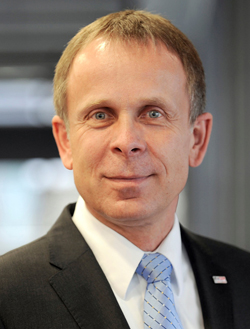
DETROIT – The current 3% penetration rate for diesel engines in U.S. light vehicles might sound low, but diesel technology specialist Robert Bosch says that rate will more than triple to 10% by 2015.
Today, there are 20 light-vehicle nameplates available in the U.S. with modern clean-diesel engines, but that number will double in less than three years as auto makers position their portfolios to meet the federally mandated fleet average of 35.5 mpg (6.6 L/100 km) by 2016, says Peter Marks, chairman, president and CEO of Robert Bosch LLC.
Marks says many of the additional diesel vehicles will come from U.S. and Asian auto makers, which is significant because European marques have led the way with introduction of modern diesels.
“We are continuing to innovate and believe that diesel passenger cars of the future will run even more efficiently,” Marks says in a speech to the Automotive Press Assn. here. “So much so that a diesel-powered car in 2015 could exceed 54 mpg (4.3 L/100 km) of fuel.”
Less than two years ago, the future for diesel in the U.S. was in question as auto makers and suppliers such as Bosch feared the California Air Resources Board would legislate diesels right out of the market with next-generation LEV III emissions standards, which take effect in 2016.
Diesels emit higher levels of oxides of nitrogen and hydrocarbons, and early indications from CARB suggested extreme limits for such emissions were in the works and that the regulations heavily would favor electric vehicles.
Lars Ulrich, director-marketing for Bosch Diesel Systems in North America, says talks between CARB, the auto industry and the U.S. Environmental Protection Agency have been positive and the final decision from CARB regarding LEV III is due in November.
“We are optimistic that diesel will be enabled in 2016 and beyond,” Ulrich tells Ward’s at the APA event. “That will further open the door for more diesel vehicles coming to market, certainly because now we have more clarity and predictability, which will drive further investments in this technology.”

That’s not to say the industry can coast its way to meeting LEV III, which is slated to phase in through 2025, he says.
“It’s still a very challenging goal from a technical perspective. There’s still a lot of engineering brainpower to go into that to come up with the necessary solutions, but we are very optimistic we can meet those.”
Bosch is well-positioned to capitalize on growth in the diesel segment, producing fuel injectors, common rails, high-pressure pumps, electronic control units, turbochargers and aftertreatment technology for new diesels.
Bosch also has entered the market for Selective Catalytic Reduction, which uses urea or ammonia injected in the exhaust stream to scrub NOx from diesel exhaust.
Of all the future diesels headed for the U.S. market, Ulrich says a “very high rate” will come with SCR systems, which also improve a diesel engine’s fuel efficiency.
In the U.S., the Volkswagen Jetta and Audi A3, each using the 2.0L TDI 4-cyl., function without an SCR system, using instead a NOx-storage catalyst, oxidation catalyst and regenerating particulate filter to meet 50-state emissions codes.
The same engine also will appear in the all-new VW Passat, which goes on sale in September, but it will employ SCR because the vehicle is larger and heavier.
Despite its size and identical horsepower and torque ratings, the 2.0L TDI in the Passat is rated at 43 mpg (5.5 L/100 km) on the highway, while the Jetta stands at 42 mpg (5.6 L/100 km).
Ulrich also says many of the future diesel vehicles will be larger passenger cars and utility vehicles, which explains why SCR will be necessary.
Reinforcing the need to boost fuel efficiency, Bosch says it also will:
- Start battery production through its SB LiMotive joint venture for 20 vehicles from 12 auto makers by 2013. “In the long term, we see all powertrain paths converging toward a full electric vehicle,” Marks says.
- Double worldwide sales of mild-hybrid stop/start systems from 1.3 million units in 2010 to 2.6 million in 2011.
- Launch 12 hybrid-electric vehicle programs worldwide in 2012, some of them incorporating diesel engines.
- Devote additional resources to support compressed natural gas, which reduces carbon-dioxide emissions 25%.
- Make inroads in the electric power steering market with its ZF Lenksysteme joint venture; the technology saves weight and generates 90% power savings over hydraulic systems.
As the U.S. economy recovers from the recent recession, Marks says Bosch expects to hire 1,000 associates – many of them in engineering and sales – in North America across all business sectors.
Adding employees in automotive will not require any U.S. plant expansions, he says.
“The way we went into this recession was with a clear dictate that we would continue restructuring where we needed to restructure anyhow, but we would keep the core team intact in engineering, sales and the manufacturing side,” Marks says.
“We did not downsize our activities, so we are prepared for the uptick so that we can really leverage and be available for our customers. This has turned out to be the right strategy.”



